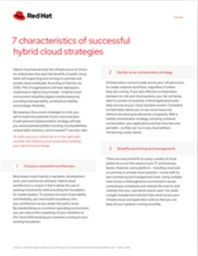7 Characteristics of Successful Hybrid Cloud Strategies
According to Gartner, by 2020, 75% of organizations will have deployed a multiload or hybrid cloud model. A hybrid cloud environment simplifies digital transformation by providing interoperability, workload portability, and strategic flexibility.
By keeping a few proven strategies in mind, you will increase the potential of your cloud solution. A well-planned implementation strategy will help you avoid potential pitfalls including incompatibilities, nonportable solutions, and increased IT security risks.
Read More
By submitting this form you agree to Red Hat contacting you with marketing-related emails or by telephone. You may unsubscribe at any time. Red Hat web sites and communications are subject to their Privacy Notice.
By requesting this resource you agree to our terms of use. All data is protected by our Privacy Notice. If you have any further questions please email dataprotection@techpublishhub.com
Related Categories: Applications, Cloud, Compliance, Digital transformation, ERP, Hardware, Hybrid Cloud, IT Security, Linux, Open Source, Operating System, Software, Storage


More resources from Red Hat

Enterprises Look to Open Source to Navigate t...
This IDC InfoBrief summarizes the findings of a global study to assess how enterprise IT infrastructure architecture strategies are evolving due ot...

How to Deploy a Comprehensive DevSecOps Solut...
Securing DevOps is a complex undertaking, DevOps tools grow and change at a fast pace. Containers and Kubernetes add more complexity and open up ne...

IT Modernization: Achieving a Balance Between...
This IDC white paper considers the challenge customers face today in balancing investments in existing infrastructure with goals of improving effic...